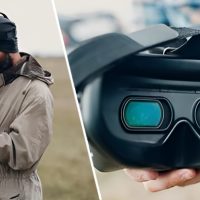Drones, those captivating aerial marvels, have revolutionized our perception of the world. They offer a bird’s-eye view of landscapes, structures, and events that were once inaccessible. But how far can a drone fly from the controller? The question first got my attention when I was enjoying my FPV drone with my friends. Here are my findings on how far drones fly from controllers.
How far can a drone fly from the controller?

The range of a drone from its controller can vary significantly depending on the specific model and technology used. Several factors affect the range of a drone, including the type of communication system, frequency, interference, and the presence of obstacles.
- Wi-Fi Drones
Drones that use Wi-Fi for communication have a shorter range, around 100 to 300 feet (30 to 90 meters). It is suitable for close-range operations and recreational use but may be better for long-distance flights.
- Radio Frequency (RF) Drones
Drones using radio frequency controllers have a longer range compared to Wi-Fi drones. The range can vary but falls within the range of 0.5 to 3 miles (0.8 to 4.8 kilometres). It is good for photography and videography.
- Lightbridge and OccuSync Technology (DJI Drones)
Some high-end drones, like those from DJI, use advanced communication technologies such as Lightbridge or OccuSync. These systems can provide a range of several miles, ranging from 4 to 7 miles (6 to 11 kilometres), depending on the model.
- Fixed-Wing Drones
Fixed-wing drones, designed for longer flights and mapping applications, can have even greater ranges. They can fly tens of miles (or more) in a single mission. These drones are used for surveying, agriculture, and other applications that require large coverage areas.
Factors Affecting Drone Range
- Radio Frequency Signal Strength
The drone’s ability to maintain control and receive commands from its operator hinges on the strength of the radio frequency (RF) signal.
This signal, akin to an invisible lifeline, connects the drone’s transmitter to the controller’s receiver, ensuring uninterrupted communication. Two factors primarily determine the range of this signal.
- Transmitter Power
The power output of the drone’s transmitter plays a crucial role in determining the signal strength. Higher power transmitters can transmit signals over longer distances, extending the drone’s flight range.
- Receiver Sensitivity
The sensitivity of the controller’s receiver dictates its ability to detect and interpret the incoming signal. More sensitive receivers can effectively receive weaker signals, allowing for longer-range communication.
- Environmental Interference
The environment plays a significant role in influencing the RF signal’s propagation. Various factors can interfere with the signal, reducing its range and potentially causing signal dropouts.
Physical objects like buildings, trees, and mountains can block or weaken the signal, limiting the drone’s flight range. Densely populated areas with numerous structures can significantly impact signal strength.
Electromagnetic fields generated by power lines, radio towers, and other electronic devices can disrupt the RF signal, leading to signal loss or erratic control.
- Drone Type and Construction
The type and construction of the drone itself can substantially impact its flight range. Two primary configurations influence range performance.
- Multi-rotor Drones
These drones, characterized by multiple propellers, typically have shorter flight ranges compared to fixed-wing drones. The propellers, while providing hovering capabilities, create drag, increasing energy consumption and reducing range.
- Fixed-wing Drones
Fixed-wing drones, with their streamlined design and wings, are more aerodynamically efficient, allowing them to fly farther on a single battery charge. Their design reduces drag and enables extended flight ranges.
- Battery Life and Power Consumption
The drone’s battery capacity, the lifeblood of its operation, plays a crucial role in determining its flight range. As the battery level decreases, the drone’s power consumption increases, potentially reducing its operational range.
The drone’s motors, responsible for propelling the drone through the air, consume significant power. Aggressive maneuvers and high altitudes demand more motor power, increasing battery consumption.
The weight of the drone’s payload, including cameras, sensors, or other attachments, directly impacts battery consumption. Heavier payloads require more power to maintain flight, reducing range.
- Weather Conditions
Adverse weather conditions can significantly impact the drone’s flight range and communication capabilities.
Water droplets and snowflakes can absorb and attenuate the RF signal, reducing its range and potentially causing signal loss.
High winds can create turbulence and instability, forcing the drone to expend more energy to maintain control. This increased energy consumption can reduce flight range.
Final words:
The maximum flight range of a drone is a complex interplay of various factors, from radio frequency signal strength to environmental interference, drone type, battery life, and weather conditions. Understanding these factors is crucial for drone operators to ensure safe and effective operation, avoiding signal loss and potential hazards. As drone technology advances, we can expect to see further improvements in signal strength, energy efficiency, and weather resistance, extending the reach of these aerial marvels and expanding their capabilities.
Jose E. Johnson is a true tech prodigy whose lifelong passion for technology and gadgets has blossomed into remarkable drone expertise. From the moment he laid eyes on his first electronic toy as a child, Jose was captivated by the limitless possibilities of innovation. As he grew, so did his fascination with cutting-edge tech, leading him to become a bona fide drone expert. With an insatiable thirst for knowledge, Jose delved deep into the intricacies of drone technology, amassing a wealth of technical knowledge and hands-on experience. Now, he shares his wisdom through insightful drone reviews and invaluable tips for fellow enthusiasts, making him a trusted source in the drone community.







Leave a Reply